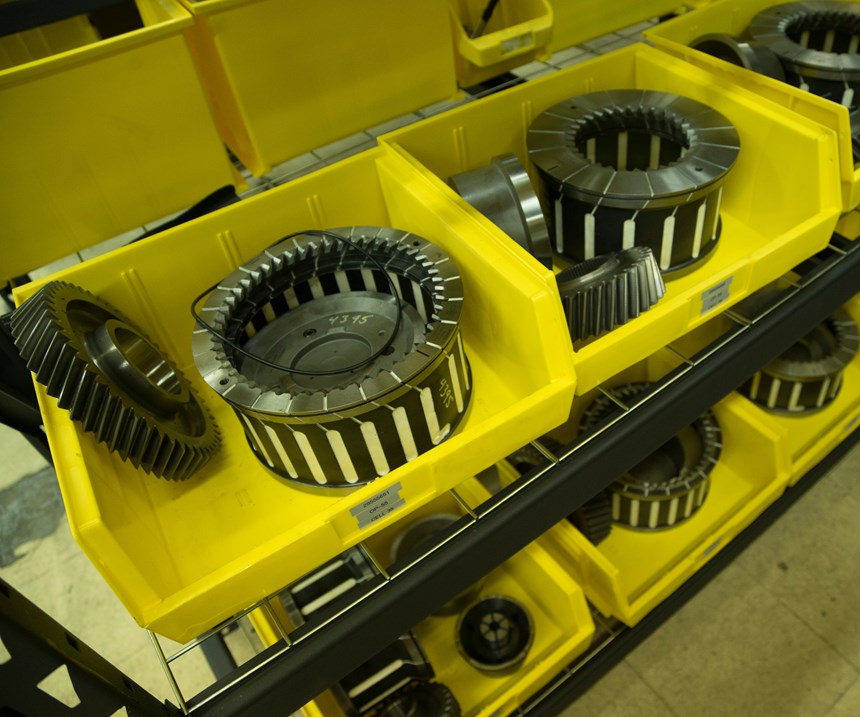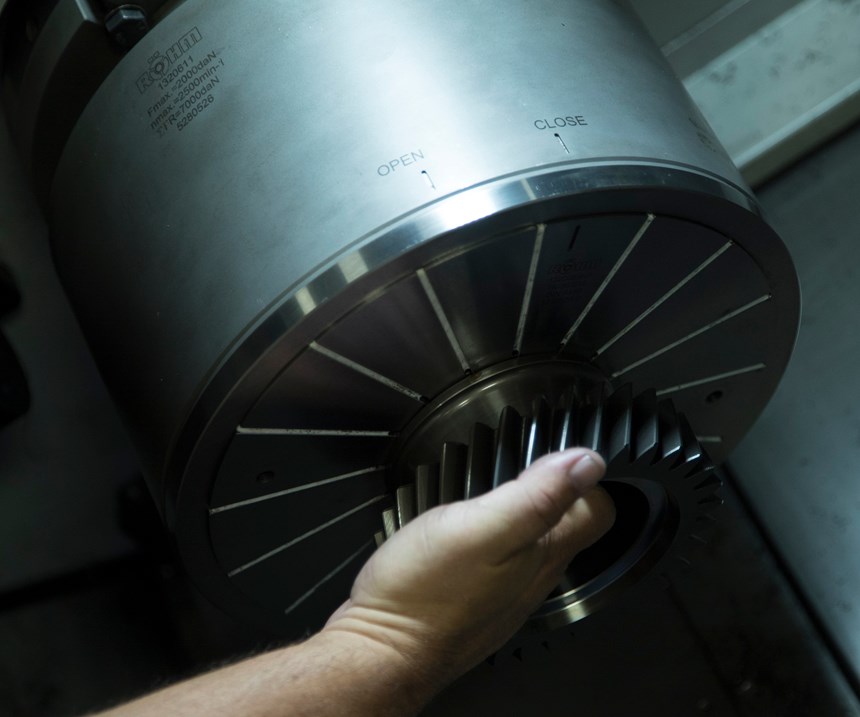Collet Chucks Overcome Distortion for Automated Gear Machining
To accommodate its customers’ need for just-in-time orders of small batches of gears, this company’s automated manufacturing cells rely on collet chucks that overcome a common distortion issue arising from tapping and heat treatment.
Share




The production of gears has changed dramatically over the past 25 years for Global Gear & Machining of Downers Grove, Illinois. While the shop once focused on dedicated pieces of standalone equipment, each pumping out one type of gear in batches of hundreds of thousands, this production method is no longer viable. Its customers now want gears in small batches delivered on a just-in-time (JIT) basis to avoid the cost of stocking large amounts of gears for their manufacturing operations. To meet these demands and maintain its competitiveness, Global Gear has turned to completely automated, flexible manufacturing cells that enable the shop to cost-effectively produce higher volumes of gears in smaller batches with JIT delivery. Most importantly, the cells can quickly and easily change over from one gear type to the next.
With the automated cells, the company has been able to increase its output while maintaining its existing workforce and taking on more work. Job lot sizes may be lower, but part tolerances are tighter than ever, and cell change-overs now happen daily.
The Importance of Workholding for Cellular Flexibility
The shop produces gears for transmission companies, many of which supply the automotive industry: Allison Transmission, American Axle and others. These gears are used in diesel-engine vehicles, transmissions, motorcycles, off-road equipment, agriculture systems and other applications. In addition to gear production, the shop also provides contract value-added machining. Gears range in size from less than 0.5 inch to as large as 16 inches in diameter, and the shop pumps out 2 to 3 million gears per year in both high- and low-volume orders.
Within the automated machining cells, flexibility and fast change-over hinge on several key factors, one of which is workholding. Cell workholding must enable the shop to do these change-overs as quickly and as effortlessly as possible while also providing the capability to be loaded by the automation system. “In a cell-based manufacturing environment like ours, when workholding fails or takes too long to change over, it shuts down the entire production of that cell,” says Ricky Quek, engineering manager.
The most common chuck design for hard-turning applications utilizes a jaw with three to six points of contact. Unfortunately, the processes of hobbing and heat treating can distort the teeth of a gear. This distortion can then interfere with clamping. If a jaw clamps down on a distorted tooth, the whole workpiece will be at an offset angle, which interferes with inspection can potentially lead to a scrapped part. Compensating for this phenomenon involves spending time on a series of inspections and adjustments, repeating and rechecking until the gear is correct. For each inspection, Global Gear would have to wait for one of its inspectors to have an opening. However, the KZF-S collet chuck from Röhm Products of America (Suwanee, Georgia) has proven to provide gripping that heat treating will not offset.
A Collet Chuck Made for Gears
Four of the shop’s newest cells use workholding from Röhm, and two of those cells use the KZF-S. Rather than clamping onto a few points of a gear’s diameter, the collet tightens the chuck on all points of a gear’s teeth, improving accuracy and ensuring the gear’s diameter is in precise relation to its pitch line. In addition to the improved precision, the workholding solution has improved repeatability and gear cylindricity.
The chuck works on a BT-style collet principle: a bayonet-style mounting system similar to mounts for camera lenses. The chuck’s collets are longer and have two points of support: the taper for accuracy and the back face for parallelism. For holding gears, the collets have a gear tooth pattern. With air sensing, the chucks can detect if a workpiece is seated improperly and, in those instances, will alert the machine controller.
“We must have an extremely accurate collet chuck, one in which we are able to load a gear, make the first cut, inspect it and produce a perfect part,” Mr. Quek says. “Most shops will focus on the time it takes to change out a chuck, but that’s only one part of the equation. The time involved with making two or three adjustments to get the part right is the real time killer.” Clamping on every tooth as the KZF-S does eliminates such variations and discrepancies, essentially taking an average of all the teeth locations and avoiding inspection errors. The ability to more accurately hold distorted gears is especially critical for the shop’s fully automated cells because it ensures that gears load properly, preventing scrapped parts as well as potential machine crashes.
Integrating the Chuck into Global Gear’s Automated Cells
For Global Gear, loading these chucks using automation was a challenge. A robot can easily load gears onto the three or six pins of a conventional pin-style chuck, but doing so with a collet chuck is more involved in terms of programming the robot’s movements. The fact that the gear teeth were on a helix pattern further complicated the task.
The company eventually was able to develop a fully automated loading sequence. First, the cell’s robot locates the front of the gear and carries it to the chuck in the turning machine. Then, the robot assumes a free-floating rotational-axis orientation. This free-floating state essentially enables the gear to guide itself into the chuck as the robot applies inward pressure, much the same way a human hand would move if the gear was loaded manually.
Change-overs at Global Gear typically take only a few hours, and the shop tries to do them in the mornings during the day shift so that the second shift is ready to run production. In addition to changing the workholding, the transition from one job to the next involves changing over an entire cell’s tooling, programs, robots, inspection, in-process gaging and finishing processes.
“During the incorporation of automated cells, it was a bit of a risk on our part when considering the Röhm chuck as a workable solution,” company President Cory Ooyen says. “We were skeptical until they showed us just how fast and easy the chucks change over, how they would work with our automation and how precisely they hold parts.” What he says really won him over, however, was the chuck’s repeatability: “While our other workholding requires fine-tuning with every change-over, once this chuck’s location is established we can maintain perfect repeatability from one collet or job change to the next, without any tweaking.”
Related Content
Using Automation to Reduce COGS and Stay Globally Competitive
Decade-long, multiphase automation investments lower operating costs and maintain technology lead in an increasingly competitive global market.
Read MoreShop Doubles Sales with High-Mix, Low-Volume Automation
Robots with adaptive grippers have opened entire shifts of capacity to high-mix, low-volume shop Précinov, doubling its sales.
Read MoreLean Approach to Automated Machine Tending Delivers Quicker Paths to Success
Almost any shop can automate at least some of its production, even in low-volume, high-mix applications. The key to getting started is finding the simplest solutions that fit your requirements. It helps to work with an automation partner that understands your needs.
Read MoreFixturing Castings Made Simple Through Adhesive Workholding
When a casting proved too malleable for traditional gripping, Thomas/Euclid Industries adopted — and succeeded with — Blue Photon adhesive workholding.
Read MoreRead Next
Setting Up the Building Blocks for a Digital Factory
Woodward Inc. spent over a year developing an API to connect machines to its digital factory. Caron Engineering’s MiConnect has cut most of this process while also granting the shop greater access to machine information.
Read MoreBuilding Out a Foundation for Student Machinists
Autodesk and Haas have teamed up to produce an introductory course for students that covers the basics of CAD, CAM and CNC while providing them with a portfolio part.
Read More5 Rules of Thumb for Buying CNC Machine Tools
Use these tips to carefully plan your machine tool purchases and to avoid regretting your decision later.
Read More
























.png;maxWidth=300;quality=90)









